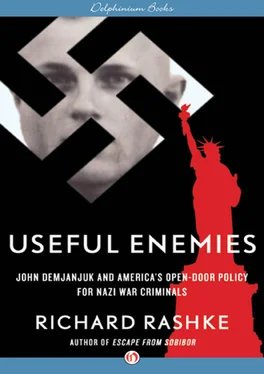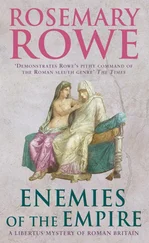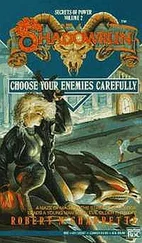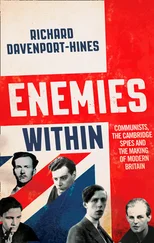Asked if he meant that Jews today wanted to frame Demjanjuk as they had framed Christ, Brentar said: “Who else? Who else?… Here was the poor innocent man, standing there like Christ before Pilate. And [the Jews] had witnesses who were not telling the truth… yelling ‘Let his blood be upon us and our children.’”
Brentar went on in the interview to call all Jewish Holocaust survivors Nazi collaborators “because they cooperated with the Germans” to stay alive. Asked if he thought of himself as an anti-Semite, he replied: “Absolutely not! Look, I’m a Catholic. I pray to a Jew every day, and to his Jew-mother.”
Edward O’Connor, a right-wing Catholic, had graduated from the University of Notre Dame and the Jesuit-staffed Niagara University in Buffalo, New York. Immediately after the war, O’Connor headed the War Relief Services of the U.S. National Catholic Welfare Conference in Europe. He fully supported his church’s unspoken anticommunist platform—Catholic fugitives from communist countries would be sponsored by the American Catholic Church and once in America, they would be helped even if they had collaborated with the Nazis.
O’Connor’s actions and decisions clearly demonstrated his Catholic and pro-Nazi bias. As a member of the Displaced Persons Commission, O’Connor “forced through” the DPC decision to make members of the Baltic Legions eligible for U.S. visas. It was a position strongly supported by the American Catholic Church because so many former legionnaires were Latvian Catholics.
Also as a member of the DPC, O’Connor supported another controversial commission decision. In 1950, the CIA began asking refugee organizations for the names and addresses of all displaced persons in the United States. Some groups balked at the request because it was not clear whether the information the CIA wanted was “confidential.” DPC agreed to nudge the organizations that were refusing to cooperate. “It is altogether desirable,” the DPC advised, “that local representatives of the voluntary agencies and State Commissions and Committees make available to fully identified CIA agents the addresses of displaced persons.”
Two years later, O’Connor also championed the 1952 Immigration and Naturalization Act (Public Law 414), which opened America’s door to Nazi war criminals who had never been convicted. And as chairman of the National Security Council’s psychology and strategy board, O’Connor fully endorsed and participated in planning Cold War covert actions that depended on former Nazi collaborators.
O’Connor was “the single most important activist” in the Anti-Bolshevik Bloc of Nations (ABN), a neo-Nazi group, according to Christopher Simpson, author of the 1988 groundbreaking book Blowback. Dominated by members of Ukrainian organizations defined as inimical to the United States by the Displaced Persons Commission, ABN had at least half a dozen well-known Nazi collaborators on its board of directors. Most notorious among them were Alfreds Berzins and Radoslaw Ostrowsky (in Belorussian, Radaslau Astrouski). Berzins was an anti-Semitic Latvian lieutenant in the Waffen SS accused of torturing, killing, and deporting two thousand Jews. He was on CROWCASS Wanted List Number 14. Ostrowsky was the former puppet president of Nazi-occupied Belorussia and president of Belorussia’s government-in-exile until his death in 1979. The Nuremberg tribunal defined Nazi quislings like Ostrowsky as criminals.
Funded by the CIA and billed as patriotic, pro-American, and anticommunist, ABN attracted right-wing Republicans, neo-Nazis, anti-Semites, and Holocaust deniers like Jerome Brentar and Austin App, author of The Six Million Swindle and the reputed father of Holocaust revisionism. ABN was so convincingly apple-pie American that it persuaded the U.S. Congress to pass unanimously a “Captive Nation Week” resolution in 1959.
O’Connor was no fan of OSI, whom he would later call a KGB collaborator, in a lengthy article in the Ukrainian quarterly.
• • •
On the morning Michael Pap took the stand to defend John Demjanjuk, two hundred Ukrainians peacefully demonstrated in the square outside the court building in support of his testimony. They were waving the blue and yellow flag adopted in 1918 as the national symbol of the short-lived Ukrainian People’s Republic.
John Martin began his direct examination of Pap by noting that Moscow kept lists of Soviet citizens who had been forced laborers and POWs. Moscow considered both groups Nazi collaborators and traitors.
Martin needed to establish that refugees knew about the lists and feared the Soviet repatriation teams that visited DP camps. “Were you familiar with the list of collaborators that was passed around?” he asked Pap.
“Yes. Up until about 1947—and even into 1948,” Pap said, “Soviet authorities were permitted to provide [to the IRO] a list of names of those people whom they suspected to have been Nazi collaborators.”
“Did you ever see such a list?”
“Yes.”
“And if a person’s name was on this list… what, if anything, would happen to him?”
“He would be deported,” Pap said. “From 1948… the deportation was not enforced. But still the people were very much afraid.”
“Are there any figures available as to how many… Soviet [civilians] were repatriated forcibly between the end of the war and 1948?” Martin asked.
“Over two million.”
“Were you familiar with the policy whereby an applicant might give a place of birth as a small town somewhere in Poland?”
“It was basic knowledge.”
“Do you have an opinion why this was done?”
“Because they were afraid that if they would identify themselves as former citizens of the Soviet Union, they would be simply deported to the Soviet Union,” Pap said. “The Soviet Constitution reads: ‘desertion to the enemy… shall be punishable with all the severity of law as the most heinous of crimes.’”
“What would happen to a… prisoner of war if he was returned to the Soviet Union?”
“Two and a half million were deported,” Pap explained. “About a million were executed immediately and the rest were sentenced to fifteen years of hard labor.”
Pap turned to Judge Battisti: “In 1957, Your Honor, an amnesty was offered by Khrushchev. Only twenty percent of those [deported] were still alive.”
“Twenty percent of what figure?” Battisti asked.
“Of the two and a half million.”
Pardon for political prisoners, including former POWs and their families, was part of Khrushchev’s de-Stalinization program. He issued the decree in September 1955, not in 1957.
“Based on your research and studies of the Soviet Union, did it ever come to your attention where the Soviet Union… participated in forged documents?” Martin asked.
“Yes. From the inception of the Soviet government, the basic preoccupation was to forge evidence,” Pap said.
“Do you have an opinion as to why the Soviet government… would be interested in presenting or providing some type of discord between the Ukraine and Jewish people?”
“Objection, Your Honor.”
“Sustained.”
The question was speculative and Pap was not an expert on Soviet internal politics. Battisti’s ruling was a temporary setback for the defense.
• • •
Moscowitz conducted the cross-examination of Professor Pap. He began with an attempt to taint his testimony as totally biased. “I take it that you consider yourself an opponent of the Soviet government, is that correct?”
“Based on the research and documents I have examined,” Pap said.
“For example, you’re in favor of an independent Ukraine?”
Читать дальше












